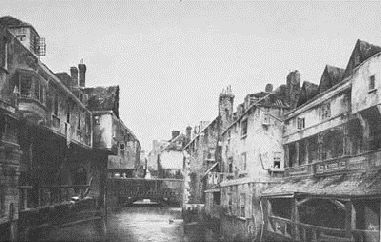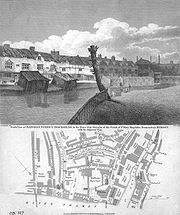
Jacob's Island
Encyclopedia

Rookery (slum)
A rookery was the colloquial British English term given in the 18th and 19th centuries to a city slum occupied by poor people...
in Bermondsey
Bermondsey
Bermondsey is an area in London on the south bank of the river Thames, and is part of the London Borough of Southwark. To the west lies Southwark, to the east Rotherhithe, and to the south, Walworth and Peckham.-Toponomy:...
, on the south bank of the River Thames
River Thames
The River Thames flows through southern England. It is the longest river entirely in England and the second longest in the United Kingdom. While it is best known because its lower reaches flow through central London, the river flows alongside several other towns and cities, including Oxford,...
in London
London
London is the capital city of :England and the :United Kingdom, the largest metropolitan area in the United Kingdom, and the largest urban zone in the European Union by most measures. Located on the River Thames, London has been a major settlement for two millennia, its history going back to its...
. It was separated from Shad Thames
Shad Thames
Shad Thames is an historic riverside street next to Tower Bridge in Bermondsey, London, England, and is also an informal name for the surrounding area...
to the west by St Saviour's Dock
St Saviour's Dock
St Saviour's Dock is a small dock on the south bank of the River Thames, London. It is located approximately 400 metres east of Tower Bridge and forms the eastern boundary of the picturesque and historic area of London known as Shad Thames...
, the point where the subterranean
Subterranean rivers of London
The subterranean or underground rivers of London are the tributaries of the River Thames and River Lea that were built over during the growth of the metropolis of London...
River Neckinger
River Neckinger
The River Neckinger is a subterranean river that rises in Southwark and flows through London to St Saviour's Dock where it enters the River Thames. The river is now totally enclosed and runs underground.-History:...
enters the Thames, and on the other two sides by tidal ditches, one just west of George Row and the other just north of London Street (now named Wolseley Street).
Jacob's Island was immortalised by Charles Dickens
Charles Dickens
Charles John Huffam Dickens was an English novelist, generally considered the greatest of the Victorian period. Dickens enjoyed a wider popularity and fame than had any previous author during his lifetime, and he remains popular, having been responsible for some of English literature's most iconic...
's novel Oliver Twist
Oliver Twist
Oliver Twist; or, The Parish Boy's Progress is the second novel by English author Charles Dickens, published by Richard Bentley in 1838. The story is about an orphan Oliver Twist, who endures a miserable existence in a workhouse and then is placed with an undertaker. He escapes and travels to...
, in which the principal villain Bill Sikes
Bill Sikes
William "Bill" Sikes is a fictional character in the novel Oliver Twist by Charles Dickens.He is one of Dickens's most vicious characters and a very strong force in the novel when it comes to having control over somebody or harming others. He is portrayed as a rough and barbaric man. He is a career...
meets a nasty end in the mud of 'Folly Ditch'. Dickens provides a vivid description of what it was like:
- "... crazy wooden galleries common to the backs of half a dozen houses, with holes from which to look upon the slime beneath; windows, broken and patched, with poles thrust out, on which to dry the linen that is never there; rooms so small, so filthy, so confined, that the air would seem to be too tainted even for the dirt and squalor which they shelter; wooden chambers thrusting themselves out above the mud and threatening to fall into it - as some have done; dirt-besmeared walls and decaying foundations, every repulsive lineament of poverty, every loathsome indication of filth, rot, and garbage: all these ornament the banks of Jacob's Island."
Dickens was taken to this then-impoverished and unsavory location by the officers of the river police, with whom he would occasionally go on patrol. When a local politician attempted to deny the very existence of Jacob's Island, Dickens gave him short shrift, describing the area as "the filthiest, the strangest, the most extraordinary of the many localities that are hidden in London". The area was once notoriously squalid and described as "The very capital of cholera
Cholera
Cholera is an infection of the small intestine that is caused by the bacterium Vibrio cholerae. The main symptoms are profuse watery diarrhea and vomiting. Transmission occurs primarily by drinking or eating water or food that has been contaminated by the diarrhea of an infected person or the feces...
" and "The Venice
Venice
Venice is a city in northern Italy which is renowned for the beauty of its setting, its architecture and its artworks. It is the capital of the Veneto region...
of drains" by the Morning Chronicle
Morning Chronicle
The Morning Chronicle was a newspaper founded in 1769 in London, England, and published under various owners until 1862. It was most notable for having been the first employer of Charles Dickens, and for publishing the articles by Henry Mayhew which were collected and published in book format in...
of 1849. The ditches were filled in the early 1850s, and the area later redeveloped as warehouses.

Henry Mayhew
Henry Mayhew was an English social researcher, journalist, playwright and advocate of reform. He was one of the two founders of the satirical and humorous magazine Punch, and the magazine's joint-editor, with Mark Lemon, in its early days...
described Jacob's Island thus:
- "On entering the precincts of the pest island the air had literally the smell of a graveyard, and a feeling of nausea and heaviness came over any one unaccustomed to imbibe the moist atmosphere. Not only the nose, but the stomach told how heavily the air was loaded with sulphuretted hydrogen; and as soon as you crossed one of the crazy and rotten bridges over the reeking ditch, you knew, as surely as if you had chemically tested it, by the black colour of what was once white lead paint upon the door posts and window sills, that the air was thickly charged with this deadly gas. The heavy bubbles which now and then rose up in the water showed you whence at least a portion of the mephitic compound issued, while the open doorless privies that hung over the water-side, and the dark streaks of filth down the walls, where the drains from each house discharged themselves in to the ditch were proofs indisputable as to how the pollution of the ditch occurred.
- "The water was covered with scum almost like a cobweb, and prismatic with grease. In it floated large masses of rotting weed, and against the posts of the bridges were swollen carcases of dead animals, ready to burst with the gases of putrefaction. Along its shores were heaps of indescribable filth, the phosphoretted smell from which told you of the rotting fish there, while the oyster-shells were like pieces of slate from their coating of filth and mud. In some parts the fluid was as red as blood from the colouring matter that poured into it from the reeking leather dressers’ close by."
Jacob's Island was extensively bombed during the Second World War and today only one Victorian warehouse survives. Over the past twenty years the Island area has undergone considerable regeneration and gentrification, including a development by architects Lifschutz Davidson Sandilands
Lifschutz Davidson Sandilands
Lifschutz Davidson Sandilands is a practice of architects, urban designers and masterplanners established in 1986 and practicing out of London.-History:...
.

